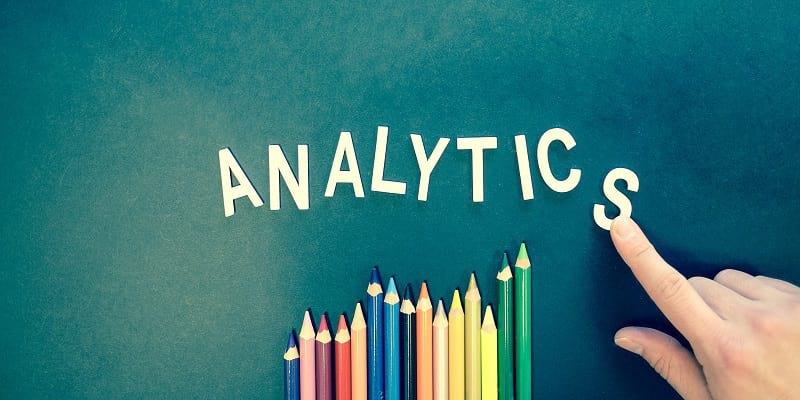Data Analytics: the theory explained

Data Analytics: This article explains data analytics in a practical way. The article starts with the general meaning of data analysis, its relationship with business intelligence and information about the role of a data analyst. The article also discusses various examples of types of data analysis and which techniques are used. Enjoy reading!
What is Data Analytics?
Data analytics is the systematic analysis of data or statistics. It is used for identifying, interpreting and communicating patterns in data that are of great value to business decision-making.
Organizations further use data analytics to describe, predict, and improve business performance. Most organizations collect huge amounts of data. In raw form it is difficult to give meaning to this data. That’s exactly where this comes in.
What does a data analyst do?
A data analyst is mainly concerned with extracting or analyzing this raw data. The data is transformed into comprehensible, coherent and lean information blocks (data visualization). After the analyst interprets the data, this person reports the findings to the relevant individuals.
Business intelligence
Data analytics can be seen as a form of business intelligence. It is used to address specific problems within an organization. The focus is on establishing patterns in datasets that the organization can deploy in the short term. For example, discovering patterns in data can reveal how customers behave during the customer journey, or how employees interact with certain software.
Data analytics ensures that a company’s past is better understood and that future trends can be better predicted. With effective data management, it becomes possible to make decisions based on what the data reveals.
Data science and Data Analytics
Data science and data analytics are often confused. Although intertwined, the two have different configurations. Moreover, both have a different impact on an organization.
A key difference between data scientists and data analysts lies in the nature of what they do. A data analyst tries to answer case study specific questions because of a challenge an organization is confronted with. A data scientist on the other hand considers what questions organizations should be asking themselves. They are engaged in data modelling, predictive models or writing new algorithms.
Another important difference lies in the techniques and skills required for both fields. Data analysts are expected to be able to work well with software such as Excel and sometimes programming software. They are familiar with such software and are engaged in data mining, statistical analysis, data management and reporting.
Data scientists often need to be proficient in Java, machine learning, programming languages, software development, and data analytics.
Despite the differences between the two, they are both immensely valuable to business.
Types of Data Analytics
The four main types of data analytics are explained in practical terms below. They are:
- Descriptive analytics
- Diagnostic analytics
- Predictive analytics
- Prescriptive analytics
Descriptive analytics
Descriptive analytics is a simple and superficial analysis that mainly focuses on things from the past. In general, it is a short process, where the analyst first collects, interprets and then presents information in a concise format. It is important for the analyst to ensure that others easily understand what is meant by the information.
Diagnostic analytics
Diagnostic analytics focuses on the ‘why’. The analysts involved in this work try to identify and explain anomalies in data sets. For example, if the data shows that there was a sharp drop in sales in the month of April, it’s up to the data analyst to investigate the cause.
Predictive analytics
The predictive analytics tries to predict what will happen in the future. Data analysts are mainly concerned with coming up with actionable insights from the data that the company can use to take new steps. Predictive analytics estimates the probability of an event based on historical data.
These analyses are used to predict all kinds of different outcomes. The ultimate goal of the analysis is to increase a company’s opportunities and help achieve organizational goals.
Prescriptive analytics
Prescriptive analytics is more complex than the aforementioned analytics and often includes elements of working with algorithms, machine learning, and modeling techniques. Effective use of this type of analytics can make all the difference to organizations and have a huge impact on decision-making and results.
Steps in data analytics
What the data analytics process looks like exactly depends on the situation. In general, a number of basic steps are followed before the information is processed in one of the above analyses. These basic steps are briefly described below.
Establishing goal and requirements for Data Analytics
The first step involves determining the need for data analytics and the requirements. During the first phase, it is also determined what kind of data is involved. Is it data on demographic characteristics, such as income or gender? Or is it working with financial data?
Collecting data
The second step in the data analytics process is actually collecting the data. This comes from various sources, such as databases, online sources, cameras or personnel.
Organizing and transferring
The third step involves organizing the data that has been collected. This means that the data is scanned for, for example, duplicates and deviations. Adding this step ensures that any errors are fixed before the data analyst gets to work with them.
Data analytics techniques
Some popular data analytics techniques include:
Regression analytics
Regression analytics involves analyzing relationships between dependent variables with the aim of determining how a change in one variable may affect the other.
Factor analytics
With a factor analytics, a large dataset is taken and divided into smaller datasets. The purpose of this activity is to discover hidden trends that are difficult to identify in a large pile of information.
Monte Carlo simulations
Monte Carlo simulations model the probability of different outcomes. These simulations are used for loss prevention and risk mitigation. This method is quite capable of making forecasts.
Time series analytics
Time series analytics involves tracking and analyzing data over a period of time. This technique is widely used to determine cyclical trends or to make financial forecasts.
Example data analytics in practice
One area where data analytics has a huge impact is healthcare. For example, a system has been devised that helps patients manage their asthma using wireless inhalers and a special algorithm for analyzing data.
That data is obtained via the Bluetooth inhaler, which is equipped with a sensor. Each time the inhaler is used, the sensor sends data to a connected smartphone. This data ends up on a server, where it goes through an algorithm.
This algorithm helps create a picture of the patient, for example about patient demographics, certain behaviors, sensitivity to environmental factors and asthma triggers.
This application shows that data analytics really make a difference when it comes to delivering effective care. By collecting and analyzing the right data, the needs of the patient can be better met (informed decision).
Now It’s Your Turn
What do you think? Do you recognize the explanation about data analytics? Have you ever been involved in analyzing data in one way or another? Is there a data analyst in your work environment? Do you find working with data and raw data interesting? Do you have questions or comments about this article or related topics? Let us know in the comments.
Share your experience and knowledge in the comments box below.
More information
- Tsai, C. W., Lai, C. F., Chao, H. C., & Vasilakos, A. V. (2015). Big data analytics: a survey. Journal of Big data, 2(1), 1-32.
- Runkler, T. A. (2020). Data analytics. Springer Fachmedien Wiesbaden.
- Abt, K. (1987). Descriptive data analysis: a concept between confirmatory and exploratory data analysis. Methods of information in medicine, 26(02), 77-88.
- Nassaji, H. (2015). Qualitative and descriptive research: Data type versus data analysis. Language teaching research, 19(2), 129-132.
How to cite this article:
Janse, B. (2022). Data Analytics. Retrieved [insert date] from Toolshero: https://www.toolshero.com/information-technology/data-analytics/
Original publication date: 09/19/2022 | Last update: 04/29/2023
Add a link to this page on your website:
<a href=”https://www.toolshero.com/information-technology/data-analytics/”>Toolshero: Data Analytics</a>












